| Table of Contents |
|---|
| Panel |
|---|
| Operations → Order Management → 35160146 |
Auto Orders
UltraCart's Auto Order feature allows you to set a schedule in UltraCart to "automatically" order an item for a customer on a set schedule.
(This is also known as free trials, recurring, subscription, membership, or continuity programs.)
The Auto Order feature allows a merchant to configure an item on a schedule that will be followed to automatically order again in the future.
UltraCart also gives the unique ability to use different items at different intervals in your Auto Order schedule.
...
| title | Visa Rules regarding Subscriptions |
|---|
Update Merchant Obligations
...
Auto Order Search
At times a merchant may desire to edit, disable, enable or cancel their customers "auto order". Although an email is usually (merchant option) sent to the customers with a cancellation button (link) they may call upon you, the merchant, to make changes (i.e., credit card information update).
You can enter one of 19 different search criteria to locate the customer's auto order. Your entry must be an exact match and is case sensitive. If it fails, go back to the Auto Order Search screen and try a different field (example: use email vise last name).
Auto Order Search screen
Once you've entered your criteria, click on the "Search" button. If a match is found, the Search (results) screen will then appear with a list of the order(s) that match the criteria.
Cancel Auto Orders
To cancel the customers Auto Order, click on the "Cancel" button. Make sure you select the correct order to cancel as a customer may have more than one.
Edit Auto Orders
Once you've located an auto order and it is presented in the search results list, click on the "edit" button to the right. This will take you to the Auto Order Editor screen.
Auto Order Editor Screen
Auto Order Settings
The Auto Order tab is where you can view, and enable/disable the auto order.
There are six section to the Auto Order tab in the auto order editor:
...
The Status field indicated the current status of the auto order as:
- Enabled
- Disabled (occurs when the payment for the next scheduled fails the specified attemps as configured in the Auto Order Processing Retry Settings)
- Cancelled by Customer
- Cancelled by Merchant
- Cancel After
...
Affiliate
...
The Affiliate section displays a field for "Override Affiliate ID", where you can enter an affiliateID to the order.
...
Payment Information
...
The number of billing attempts will determine when the auto order will automatically disable due to failed processing attempts.
See: Auto Order Processing#RetrySettings
This field indicates the next date the credit card will be processed after failure. The default is every 3 days. If the card fails after 3 attempts, the Auto Order will be set to inactive (the check mark in the Enable Field will automatically be removed).
...
The Items section is where you can review and modify the rebill item(s) as well as the rebill schedule.
In this section you can:
- Add additional items to the auto order
- Modify the Quantity of existing items in the auto order.
- Change the Next Item ID for the future order.
- Change the Next Shipment Date (or processing date for non shippable auto orders.
- Review and modify the Next Preshipment Notice
- Review and modify the Number of Rebills so far
- Apply the following Overrides →
Frequency - Use this drop down menu to apply a new frequency for the auto orders.
No Order After - Use this to set a date into the future that will end the auto orders. This is often used when a customer calls to cancel but agrees to one or more orders before cancelling.
Unit Cost - Use this to override the defaulted cost of the item.
Unit Cost Remaining Orders - If you have applied a Unit Cost override that is only temporary, enter the number of future orders the overridden unit cost should apply before reverting back to the defaulted item unit cost.
| Info |
|---|
| If the Unit Cost has been overridden and the Unit Cost Remaining Orders is left blank, then the overridden unit cost will continue for the remainder of the active auto order. |
Adding additional Auto Order Items to an existing auto order record
Add Item Button
The "Add" (item) button can be used to add additional items to the existing auto order.
| Info | ||
|---|---|---|
| ||
Adding a one time item to an existing auto order record Non auto order configured items can now be added into an existing auto order record.
|
Item Editing & Override fields for configured auto order items
...
Add non auto order items to existing auto orders
| Info | ||
|---|---|---|
| ||
The auto order editor now supports adding non auto order items. The auto order item editor will add the item with a "Next Shipment" date out in the future. After the item is added, you'll need to adjust the the next shipment date to match the existing items in the auto order. The interval will be set to monthly (you can use the "Overrides" to change the interval.) |
...
- Auto Order sections
- History
- Future
- Logs
- Emails
Auto Order Record
Auto Order tab
The Auto Order tab is the main tab, this is the tab where you are able to modify the auto order schedule, edit items, change frequency and next shipment date, and cancel or re-enable an auto order. (The screenshot above displays the Auto Order tab.
New Feature (06/062023) - Add-On Items
The Add-On Items section allows for the adding of items for a limited number of rebills.
To add an Add-On item:
- Click the 'Add' button then enter the Item Id of the item. You'll see a confirmation message appear at the top of the page:
- Next scroll down to the Add-On Items section to configure the 'Next X Orders'. The field will be fill with 1 by default, so edit if needed. You'll also have options for free shipping for the item as well as an arbitrary cost field (otherwise the default item cost will apply.)
- After make your adjustments, click the Save & Reload button to save the changes.
- Review the future orders tab to ensure you see the proper future order rebill schedule.
History tab
The History tab shows the orders that have been generated for the history of the auto order.
The Future tab will appear when the auto order is active, it will display the future order schedule for the active auto order.
*If the auto order is an ongoing rebill schedule, the next 20 scheduled orders will be displayed.
Auto Order Settings
The Auto Order tab is where you can view, and enable/disable the auto order.
There are six section to the Auto Order tab in the auto order editor:
...
The Status field indicated the current status of the auto order as:
- Enabled
- Disabled (occurs when the payment for the next scheduled fails the specified attemps as configured in the Auto Order Processing Retry Settings)
- Cancelled by Customer
- Cancelled by Merchant
- Cancel After
...
Affiliate
...
The Affiliate section displays a field for "Override Affiliate ID", where you can enter an affiliateID to the order.
...
Payment Information
...
The number of billing attempts will determine when the auto order will automatically disable due to failed processing attempts.
See: Auto Order Processing#RetrySettings
This field indicates the next date the credit card will be processed after failure. The default is every 3 days. If the card fails after 3 attempts, the Auto Order will be set to inactive (the check mark in the Enable Field will automatically be removed).
...
The Items section is where you can review and modify the rebill item(s) as well as the rebill schedule.
In this section you can:
- Add additional items to the auto order
- Modify the Quantity of existing items in the auto order.
- Change the Next Item ID for the future order.
- Change the Next Shipment Date (or processing date for non shippable auto orders.
- Review and modify the Next Preshipment Notice
- Review and modify the Number of Rebills so far
- Apply the following Overrides →
Frequency - Use this drop down menu to apply a new frequency for the auto orders.
No Order After - Use this to set a date into the future that will end the auto orders. This is often used when a customer calls to cancel but agrees to one or more orders before cancelling.
Unit Cost - Use this to override the defaulted cost of the item.
Unit Cost Remaining Orders - If you have applied a Unit Cost override that is only temporary, enter the number of future orders the overridden unit cost should apply before reverting back to the defaulted item unit cost.
| Info |
|---|
| If the Unit Cost has been overridden and the Unit Cost Remaining Orders is left blank, then the overridden unit cost will continue for the remainder of the active auto order. |
Adding additional Auto Order Items to an existing auto order record
Add Item Button
The "Add" (item) button can be used to add additional items to the existing auto order.
| Info | ||
|---|---|---|
| ||
Adding a one time item to an existing auto order record Non auto order configured items can now be added into an existing auto order record.
|
Item Editing & Override fields for configured auto order items
| Table of Contents |
|---|
| Panel |
|---|
| Operations → Order Management → 35160146 |
Auto Orders
UltraCart's Auto Order feature allows you to set a schedule in UltraCart to "automatically" order an item for a customer on a set schedule.
(This is also known as free trials, recurring, subscription, membership, or continuity programs.)
The Auto Order feature allows a merchant to configure an item on a schedule that will be followed to automatically order again in the future.
UltraCart also gives the unique ability to use different items at different intervals in your Auto Order schedule.
| Info | ||
|---|---|---|
| ||
Update Merchant Obligations
|
Auto Order Search
At times a merchant may desire to edit, disable, enable or cancel their customers "auto order". Although an email is usually (merchant option) sent to the customers with a cancellation button (link) they may call upon you, the merchant, to make changes (i.e., credit card information update).
You can enter one of 19 different search criteria to locate the customer's auto order. Your entry must be an exact match and is case sensitive. If it fails, go back to the Auto Order Search screen and try a different field (example: use email vise last name).
Auto Order Search screen
Once you've entered your criteria, click on the "Search" button. If a match is found, the Search (results) screen will then appear with a list of the order(s) that match the criteria.
Cancel Auto Orders
To cancel the customers Auto Order, click on the "Cancel" button. Make sure you select the correct order to cancel as a customer may have more than one.
Edit Auto Orders
Once you've located an auto order and it is presented in the search results list, click on the "edit" button to the right. This will take you to the Auto Order Editor screen.
Auto Order Editor
This Auto Order Editor is divided into 5 Tabs:
- Auto Order tab
- History tab
- Future tab
- Logs tab
- Emails tab
Auto Order tab
The Auto Order tab is where you can view, and enable/disable the auto order.
The following is a description of the Auto Order tab to the auto order editor:
| Section Name | Description | ||||||
|---|---|---|---|---|---|---|---|
Status | The Status field indicated the current status of the auto order as:
| ||||||
Affiliate | The Affiliate section displays a field for "Override Affiliate ID", where you can enter an affiliateID to the order. | ||||||
Payment Information | The Payment Information section is the section where you'll be able to update the customers credit card details, as well as review or edit the Billing Attempts and Next Billing Attempt date. The number of billing attempts will determine when the auto order will automatically disable due to failed processing attempts. This field indicates the next date the credit card will be processed after failure. The default is every 3 days. If the card fails after 3 attempts, the Auto Order will be set to inactive (the check mark in the Enable Field will automatically be removed). | ||||||
| Billing (Address) | The Billing section allows you to review and edit the billing address for the future orders. | ||||||
| Shipping (Address) | The Shipping section allows you to review and edit the shipping address for the future orders. | ||||||
| Merchant Notes | |||||||
| Items | Original Item ID - is the Item ID you assigned during creation of the item in the item editor. This field cannot be changed. Quantity - will be the Quantity of the item that the customer selected on the original order. Next Item ID - This will be the item that is processed in the next rebill. This is initially determined by the steps configured on the original item. You can manually change the itemID by typing in a new item ID. That item ID will carry forward using the same frequency as is configured in the original item auto order steps. you can manually override the frequency in the override settings. Paused - When selected the auto order will be paused, the next shipment date will be pushed back each day until it has been un-paused. Next Shipment - Represent the next time the auto order will process a new rebill. This is reset upon each rebill based upon the steps schedule of the original auto order item or the override settings. Next Preshipment Notice - This date will be populated by the 'Preshipment Days field in the Steps configuration on the original Item ID. Number of Rebills - This is initially calculated by the number of rebills for the auto order. This is used to determine the end date for a item step or the total number of rebills for installment billing configurations. OVERRIDE (Settings) - Configure these by clicking the 'Edit' button Frequency Override - Use this to override the defaulted frequency for the item rebills. No Orders After - Use this to cause the auto order to stop rebilling after a a specified date. Unit Cost - Use this to override the default item cost for future rebills. Unit Cost for Next "x" Orders - Configure this is the Unit Cost override should only process for 'x' number of future rebills. Once that rebill count is reached the item will revert to the default rebill amount. Percentage Discount - Configure a percentage discount on the unit cost for the item. | ||||||
Add Item Button | The "Add" (item) button can be used to add additional items to the existing auto order. Add non auto order items to existing auto orders
| ||||||
| Add-On Orders | New Feature (06/062023) - Add-On ItemsThe Add-On Items section allows for the adding of items for a limited number of rebills. To add an Add-On item:
|
History tab
The History tab shows the orders that have been generated for the history of the auto order.
Future Tab
The Future tab will appear when the auto order is active, it will display the future order schedule for the active auto order.
*If the auto order is an ongoing rebill schedule, the next 20 scheduled orders will be displayed.
Logs tab
The Logs tab will show a record of activity for the auto order, including rebills as well as user and customer edits to the auto order.
If you have webhooks configured, webhook activity for the auto order will appear at the bottom of the logs tab:
| Info | ||
|---|---|---|
| ||
Restrictions:
|
Emails tab
The Emails tab provides email deliverability details for both the Customer emails and the Internal user emails:
| Info | ||
|---|---|---|
| ||
Restrictions:
|
FAQ
Q: How can I generate a report of the auto orders that have one or more retries at processing the next order before a successful charge occurs?
A: A merchant comment will be added to an or "Retry successful". You can run the order comments report or perform an order export using a export mapping that contains the "merchant comments" field, then sorting the exported orders on the merchant comments field and then deleting the orders that do not contain "retry successful".
...
- NO COUPONS
- *If there are multiple auto order items items, they must all have the same schedule.
- Multiple "Customer-selectable" configured auto order items NOT SUPPORTED (we cannot be sure that they'll have the same reorder schedule.
- The current API integration with PayPal does not support recurring payments for digital items for new merchants.
PayPal policy is to not allow the addition of PayPal Enhanced Recurring Payments from paypal accounts which had the PayPal Pro integration and then subsequently reverted back to the standard Express Checkout Only configuration. (*The workaround to this, according to PayPal support, is to open a new account then integrate that account to your UltraCart account.
3rd Party API Permission for Auto Orders / Subscriptions:
If you have integrated using the third party API, then you'll need to make sure that the following permission is enabled: "Create and Manage Recurring Payments"
...
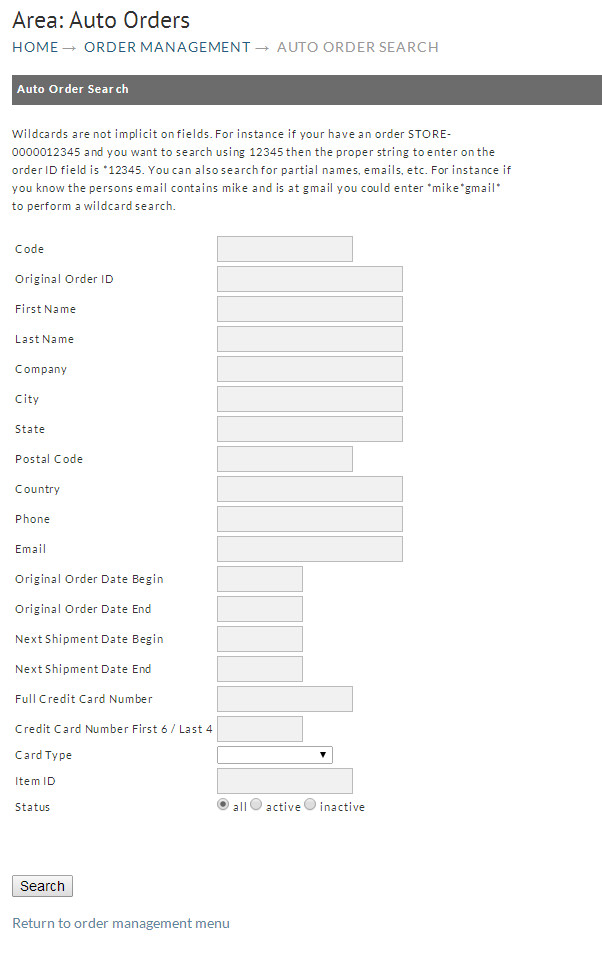
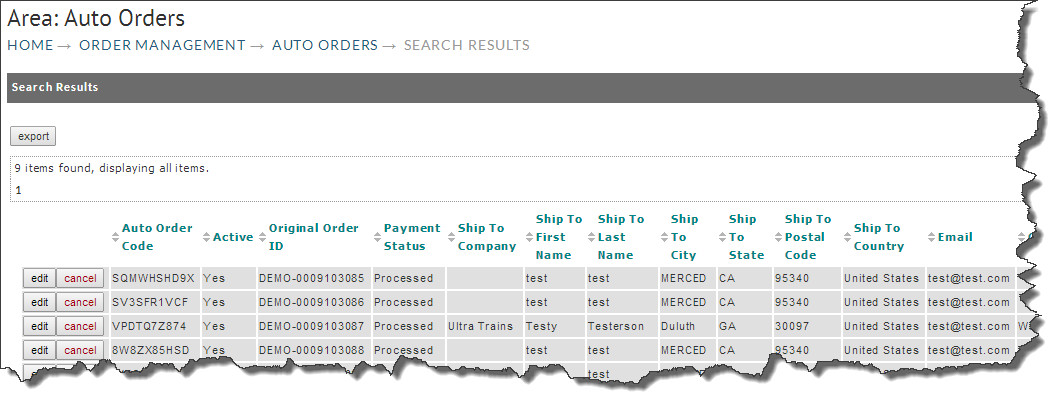
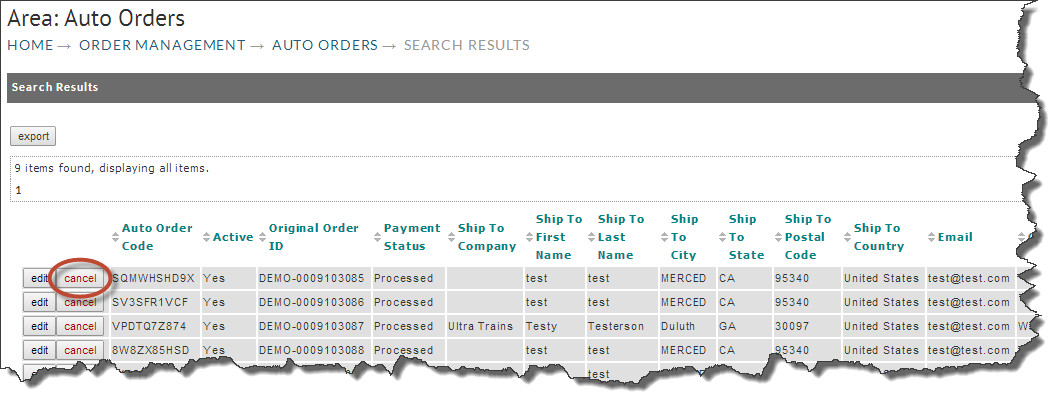
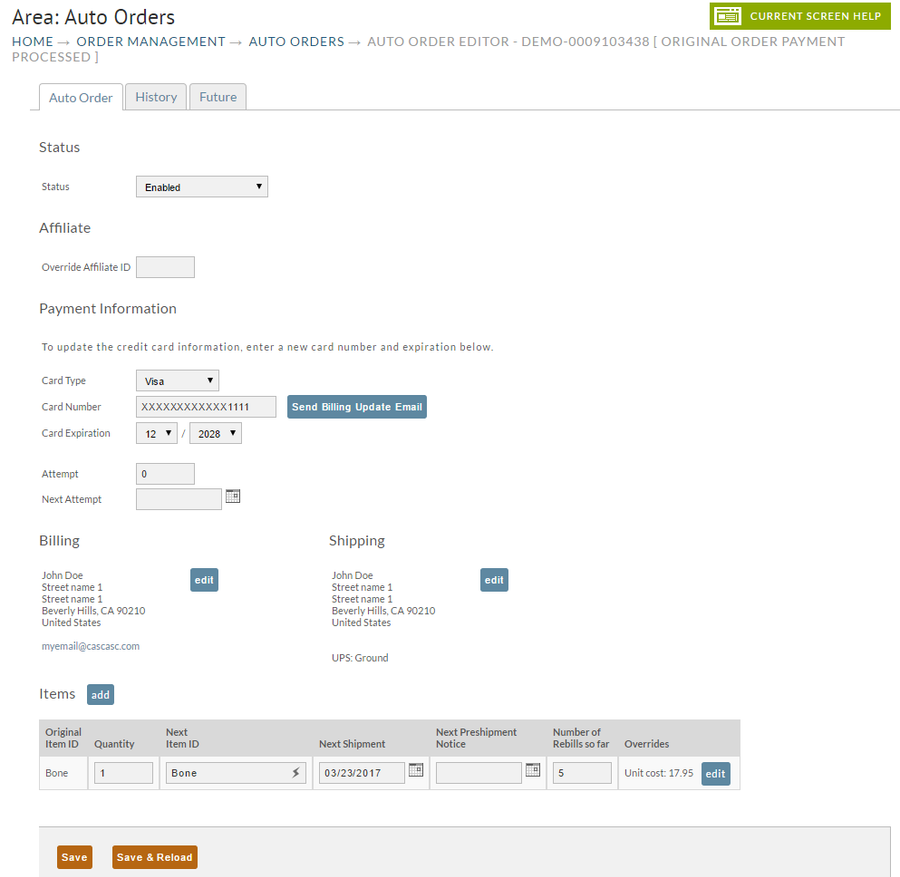
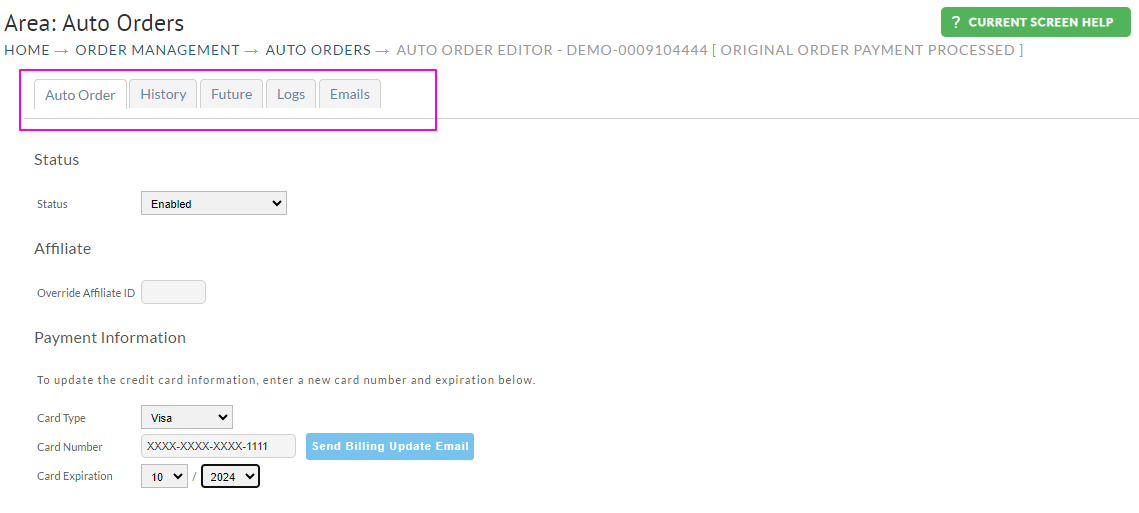
.png?version=1&modificationDate=1686081077323&cacheVersion=1&api=v2&width=700)

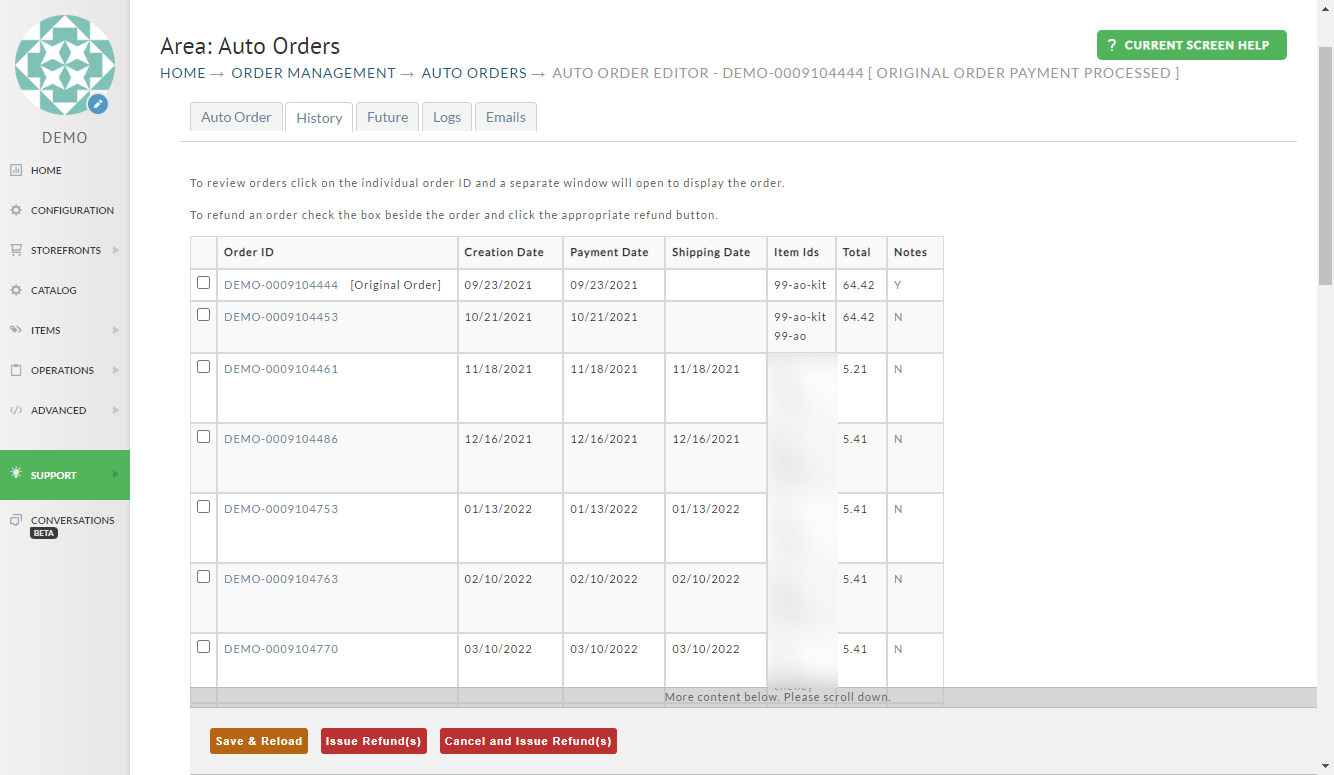
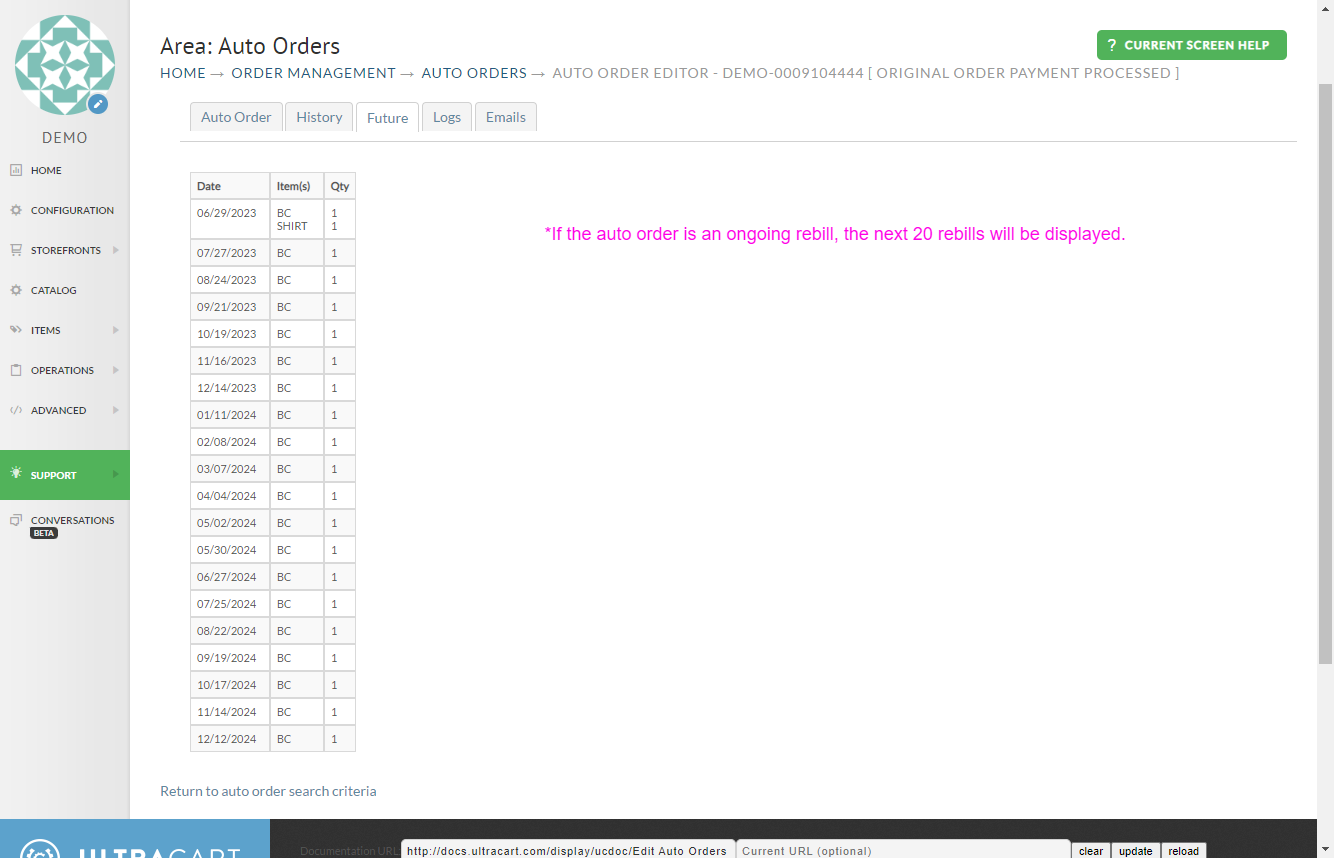
.png?version=1&modificationDate=1686081077323&cacheVersion=1&api=v2&width=900)
.png?version=1&modificationDate=1686149148818&cacheVersion=1&api=v2&width=800)
.png?version=1&modificationDate=1686149484166&cacheVersion=1&api=v2&width=800)